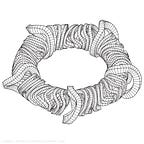The Russian Woodpecker: A Cold War Relic and the K340A Brain Behind It
The K340A computer and its role in the Soviet Duga radar system reads like something straight out of a Cold War techno-thriller. Picture this: a colossal radar array, towering over 150 meters tall and stretching over 700 meters long, hidden away in the remote forests near Chernobyl. It was the stuff of legends, secretive and imposing, capable of detecting nuclear missile launches from thousands of kilometers away. This over-the-horizon radar, better known by its infamous nickname, “The Russian Woodpecker,” would strike fear into the heart of NATO and amateur radio enthusiasts alike as its eerie tapping sound disrupted radio waves across the globe.
At the heart of this behemoth was the K340A, a computer engineered to handle the most complex of tasks: sifting through atmospheric noise to identify ICBMs in flight. Using advanced algorithms based on the residue class system, the K340A was a technological marvel, capable of rapid-fire calculations that helped distinguish real missile threats from mere background interference. It was a digital brain designed to ensure that, should the unthinkable happen, the Soviet Union would have those precious extra minutes to prepare a counter-strike.
But the scale of the Duga radar wasn’t just in its massive steel structure; its appetite for power was gargantuan, too. The radar consumed up to 40% of Chernobyl’s nuclear plant output. In fact, it was this very proximity to the Chernobyl plant that gave Duga its lifeblood. Yet, it was the 1986 disaster at the nuclear plant that spelled the beginning of the end for the radar system. Not even Duga’s lofty towers could withstand the fallout from Chernobyl’s meltdown. Coupled with the collapse of the Soviet Union and the rapid advancement of satellite technology, this giant, once seen as a symbol of Soviet strength, was rendered obsolete.
Despite its fall from grace, the Duga radar continues to fascinate. It’s become the Holy Grail for urban explorers and Cold War buffs, a rusting relic standing tall in the Chernobyl Exclusion Zone. But it’s not just the radar’s physical presence that intrigues people. Conspiracy theories have swirled for decades: was it really just an early-warning missile system, or was Duga also an instrument for mind control or weather manipulation? These claims, though largely debunked, only add to the allure of what was once the Soviet Union’s most secretive technological wonder.
Now, years later, the Duga radar looms as a decaying monument to the audacity and paranoia of the Cold War era. Despite the challenges of restoring this behemoth — high radiation levels and crumbling infrastructure — it remains a symbol of the Soviet Union’s technological prowess and a reminder of a time when the world stood on the brink of nuclear disaster. It’s a must-visit for anyone who seeks to explore the haunting remnants of Cold War history, an era of epic proportions and even greater stakes.
Welcome to my Patreon page! I’m Christian Baghai, a passionate creator dedicated to exploring and sharing insights on history, politics, and current events. By joining my community, you’ll gain access to exclusive content and in-depth analyses on the topics that matter most. Your support helps me continue to produce high-quality work. Let’s embark on this journey together!
The F-35: A Fighter Jet with a Price Tag (and a Few Hiccups) | Patreon
The Time the U.S. Army Tried to Strap Cannons to a Helicopter | Patreon
Boeing 777X: A Giant in the Sky, Stuck on the Ground | Patreon
Kamala Harris Crushes Trump in Debate: A Masterclass in Composure vs. Chaos | Patreon
Highway to Power: U.S. F-35 Jets Make History on Finnish Roads in Bold NATO Drill | Patreon
How Shocks Create Nations: A Focus on the War in Ukraine | Patreon
Donald Trump’s Climate Change Stance: A Masterclass in Ignorance and Mismanagement | Patreon
The Future of Automotive Maintenance: Harnessing Machine Learning to Predict Failures | Patreon
Taiwan’s High-Tech Power Play: Securing the Link 16 Battlefield System | Patreon
The Kremlin’s Power Play: Nationalist Movements and the Art of Thug Tactics | Patreon
